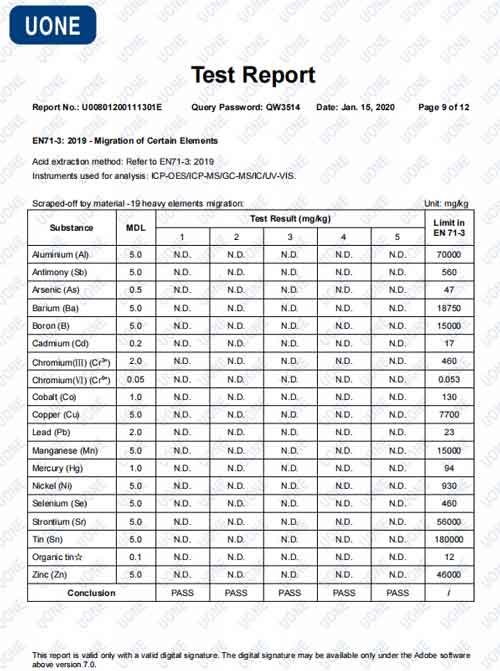When toys are imported to the EU, they all require an EN71 certificate, a common product certification in EU. Here I will explain EN71 in detail for your better understanding.
What is EN71?
As a part of the CE directive, EN71 is a mandatory standard and specifies safety requirements for toys imported into the EU. If you don’t get EN71 certification, your toys will be banned from selling in the EU. The main purpose of EN71 is to standardize toy production technology, demonstrating your products are safe to use. The testing includes chemicals and heavy metals, flammability, usage of chemicals, small parts, and mechanical properties.
EN71 mainly detects toys used by children aged 14 or under, such as plush toys, wooden toys, children’s bicycles, baby pacifiers, children’s swings, and other items. Please note that pet toys also need EN71 when imported to the EU.
In addition, some products, like frisbee, can be directly declared as outdoor products. But if you are worried about risks, you can also classify it as a toy and make an EN71 report.
14 standards of EN71 testing
EN71 certificate covers 14 sections. All section tests are to ensure that children will not suffer any harm when playing with toys. In the practice, only the first 3 parts are tested. Once passed, the toys can enter the European market for sale. Here is the first page for your reference.
The first 3 important parts
EN 71-1: Mechanical and physical properties
This part requires toys won’t collapse, or appear sharp points and edges, noise, etc., during the test, which may harm children. It also tests if toys are easy to be swallowed or not. Major testing includes a sharp point test, sharp edge test, small parts test, pressure test, bending test, impact test, etc.
Meanwhile, it regulates toy packaging, labeling, and user instructions. For example, when the toy contains functional sharp points, a warning sign shall be affixed to the outside of the packaging. It is used to draw attention to the potential danger of sharp points.
EN 71-2: Flammability
This part specifies the types of flammable materials that are prohibited for use in toys. For materials that can be used, it also sets standard limits for burning time or burning speed, which varies from one to another. For example, some toys worn on heads have ribbons. The length of the ribbons should protrude from the surface of the toy by 50mm or more.
And the burning time should be ≦ 2 seconds in the testing. When testing,
- If 50mm≦ the original length<150mm, the longest burning length should not be more than 75% of the original length.
- If 150mm≦ the original length, the longest burning length should not be more than 50% of the original length.
EN 71-3: Specification for migration of certain elements
EN71-3 testing is to simulate the digestion of any toy part. It needs to ensure the risk degree when children are exposed to 19 heavy metals such as lead, mercury, and tin. The testing method is to keep the toy material in contact with the simulated gastric juice for a period of time. And then extract the soluble elements to see if they meet the standard. Make sure all elements in the report are tested, not just show “N.R(NO require)”.
Or shown as below, N.D. means not detected, which says that the content value of the heavy metal is very low and cannot be detected. The test result is then passed.
The rest parts of EN71
The following tests are optional.
EN 71-4: Experimental sets for chemistry and related activities
EN 71-5: Chemical toys (sets) other than experimental sets
EN 71-6: Graphical symbols for age warning labeling
EN 71-7: Finger paints
EN 71-8: Swings, slides, and similar activity toys for indoor and outdoor family domestic use
EN 71-9: Organic chemical compounds – Requirement
EN 71-10: Organic chemical compounds – Sample preparation and extraction
EN 71-11: Organic chemical compounds – Methods of analysis
EN 71-12: N-Nitrosamines and N-Nitrosatable Substances
EN 71-13: Olfactory board games, cosmetic kits, and gustative games
EN 71-14: Trampolines for domestic use
How to get EN71?
You can directly contact your supplier for the EN71 certificate. He will handle it for you.
Your supplier would then contact a professional and reliable third-party testing company to prepare one for your goods. In most cases, the testing requires 2-3 samples, product instructions/a user manual, and a parts list for testing. The whole testing process takes 5-7 working days. After the test is completed, a report will be issued. If you want to conduct the test by yourself, it is OK.
As for the price, it relates to the toys’ material, performance, and complexity. Colors and materials are tested separately. For example, a teddy bear made of plush and pp cotton costs nearly $272. If the toy has 4-5 materials with 4-5 colors, it will cost more.
Source your premium toys
- Support 3000+ EU clients
- 200+ toy factories
- EN71 certified



Leave A Comment